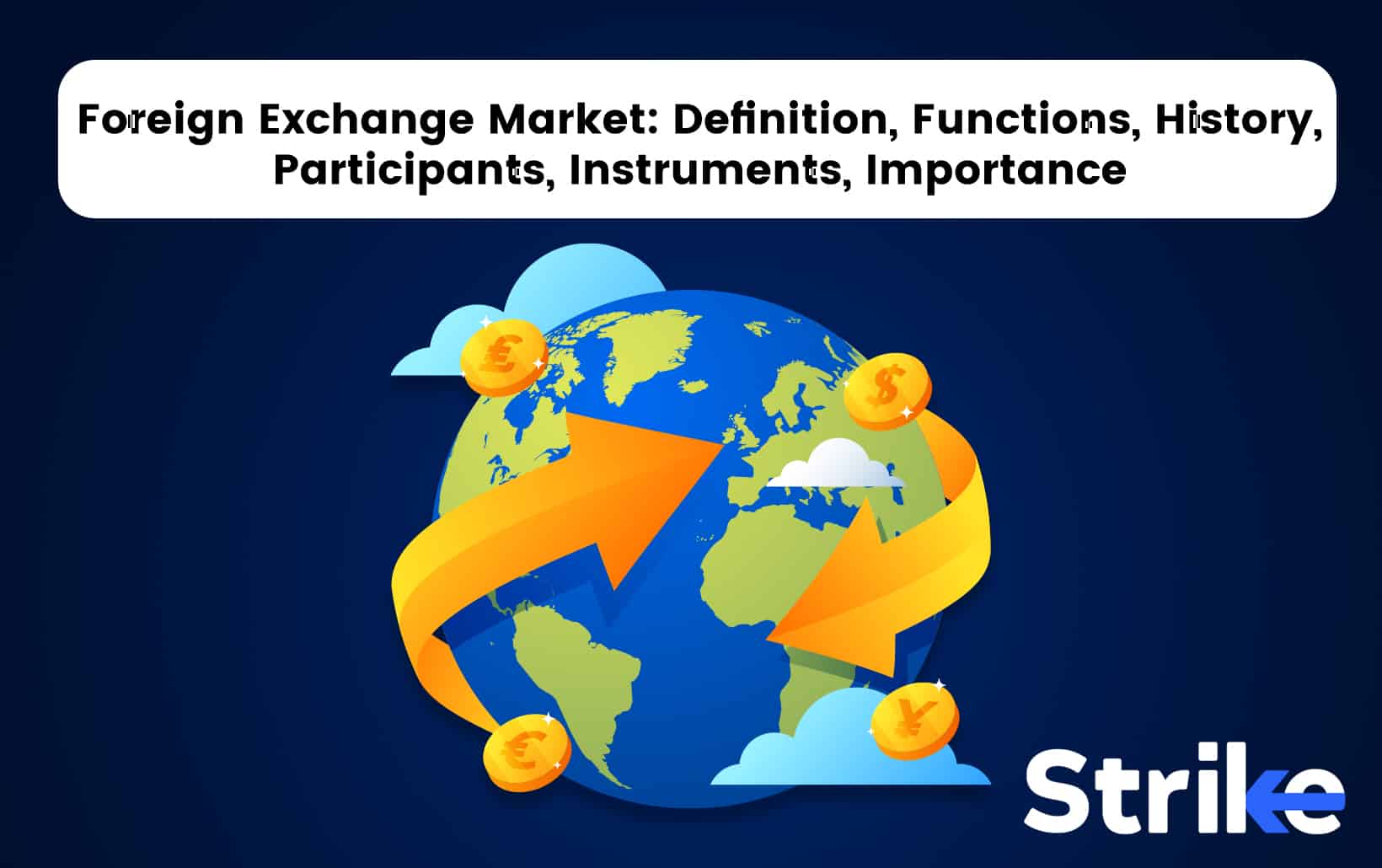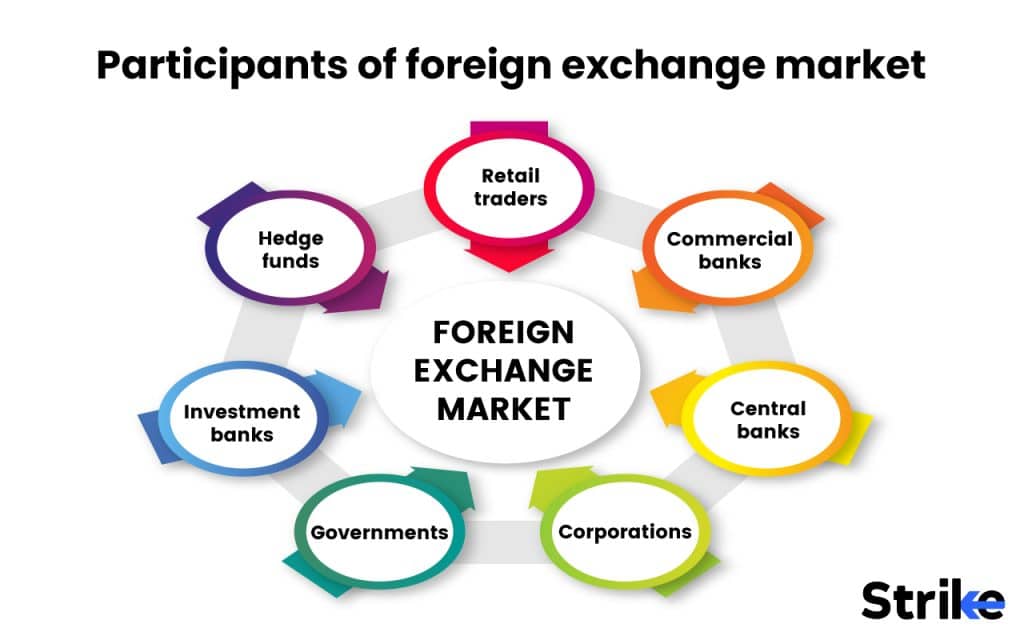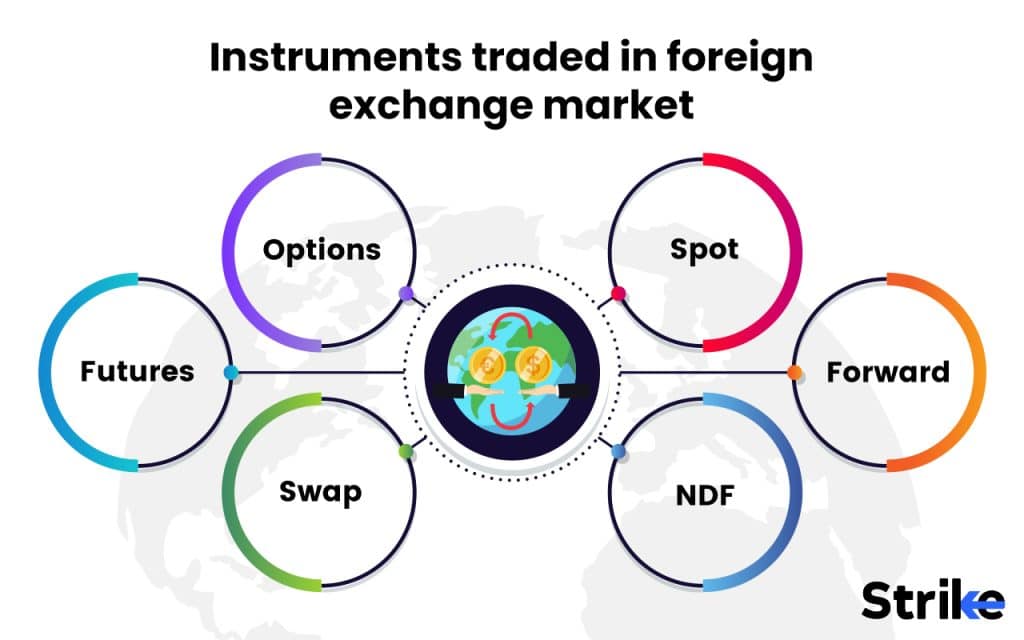
The foreign exchange facilitates international trade and financial flows while also impacting stock markets and macroeconomic conditions worldwide. The forex market deserves close attention from all market participants as the largest and most liquid financial market on the planet. Trillions of dollars change hands each day in this decentralized over-the-counter marketplace as currencies from every nation are bought and sold by commercial banks, investment funds, corporations, central banks and other key players.
This article provides a comprehensive overview of this sprawling yet vitally important market. We’ll examine the core functions and history of the forex market, from the Bretton Woods system to today’s electronic trading era. The various financial instruments traded will be defined, from spot transactions to currency futures. We’ll analyze the major currencies and geographic centres that constitute this round-the-clock global bazaar. Lastly, we’ll explore the close ties between exchange rates and factors like interest rates, trade flows, capital movements and stock market performance. With so many cross-border investments and international businesses dependent on stable currency values, understanding the foreign exchange market is essential in our interconnected world.
What is the foreign exchange market?
The foreign exchange market, also known as forex or F.X., is a global decentralized market where currencies are traded. The foreign exchange market determines foreign exchange rates for every currency. It includes all aspects of buying, selling and exchanging currencies at current or determined prices. In terms of trading volume, the forex market is the largest market in the world.
What are the functions of the foreign exchange market?
A major function of the forex market is determining the exchange rates for currency pairs. These exchange rates fluctuate based on supply and demand for particular currencies. Factors influencing supply and demand include inflation, interest rates, economic performance and geopolitical events. The exchange rates set by the forex market influence international trade, tourism, foreign investment and the competitiveness of exports. The forex market also provides currency conversion services. It allows market participants to convert one currency to another using the current market exchange rates. This facilitates international transactions and investments. Companies need to convert currencies to pay overseas suppliers or repatriate foreign earnings. Portfolio managers convert their assets into foreign currencies to diversify risk.
In addition, the forex market offers speculation and hedge opportunities. Traders speculate on exchange rate movements and currency purchases and selling based on predicted fluctuations. Companies and investors hedge foreign exchange risk using derivatives like currency swaps and futures. Hedging protects against adverse currency movements. The large size and high liquidity of the forex market help absorb these diverse transactions and generate efficient pricing. Its global nature and 24-hour trading provide constant access and smooth deals. The forex market’s infrastructure facilitates interaction between participants and the dissemination of information.
What is the history behind the foreign exchange market?
The modern foreign exchange market has its origins in the Bretton Woods agreement after World War II, which established a system of fixed exchange rates tied to the U.S. dollar. The Bretton Woods system made the U.S. dollar the official global reserve currency, pegged to gold at $35 per ounce. Other currencies had fixed exchange rates with the dollar. This brought stability after the volatility of the 1930s but also meant less flexibility for governments to pursue independent monetary policy. In the 1950s and 1960s, as European countries recovered and growth resumed, the system came under pressure. With more dollars circulating, gold reserves in the U.S. dropped. In 1971, President Nixon unilaterally ended dollar-to-gold convertibility, bringing the Bretton Woods system to an end. Currencies were allowed to float freely and find their own exchange rate based on supply and demand.
This was the start of the modern foreign exchange market. With floating rates, trading volumes rose as banks traded currencies to hedge risks and speculators sought profits from fluctuations. Currencies were traded in specific financial centres like London and Tokyo, but a 24-hour interbank network developed by the 1990s. This evolution parallels the growth of stock markets in these decades. In the 1980s, technological advances like electronic trading made forex transactions faster and cheaper. New financial instruments like currency futures opened forex markets to more investors and speculators. The influx of capital accelerated the pace of change.
Major events like the 1985 Plaza Accord, where G5 countries deliberately devalued the dollar, demonstrated the impact of forex markets on economic policy. Central banks now had to account for currency impacts when setting interest rates. Speculators like George Soros made huge profits from major currency realignments. The 1990s saw major crises – the 1992 Black Wednesday in the U.K. and the 1994 Mexican peso crisis – reveal volatility risks. The size and speed of forex trading now impacted stocks and prompted greater central bank cooperation. The creation of the euro in 1999 was a landmark event for unified European monetary policy.
In the 2000s, algorithmic trading and retail investors created even greater liquidity in forex. The 2008 financial crisis again revealed interconnected risks, with currencies and stocks plunging in tandem. Low-interest rates globally have since led central banks to use more unconventional monetary policies influencing currency values.
Who are the participants of the foreign exchange market?
The main participants in the foreign exchange market are retail traders, commercial banks, central banks, corporations, governments, investment banks, and hedge funds.

Retail traders are individual investors who speculate on the movements of currency exchange rates. They open accounts with forex brokers and trade currencies in an attempt to profit from exchange rate fluctuations. Retail forex trading has grown considerably in the past two decades due to the internet allowing 24/7 trading access and brokers offering high leverage. Commercial banks play a major role in the forex market, given their need for foreign currencies. Banks engage in forex trading to facilitate transactions for clients, manage liquidity, and profit from exchange rate moves. A country’s central bank is, at times, an active participant in the forex market. Central banks trade currencies to realign exchange rates, build foreign exchange reserves, or stabilize their own currency.
Large corporations are active in forex markets for both operational and speculative reasons. On the operational side, multinational corporations trade currencies to pay overseas suppliers or repatriate foreign earnings. Corporations need to convert payments from countries into their domestic currency, which necessitates forex trading. Corporations sometimes also hedge future payments in foreign currencies to remove currency risk from their financial statements. Governments participate in currency markets directly via their central banks and treasury departments. Foreign exchange policy is an important macroeconomic lever that governments use to influence exchange rates. A weaker currency stimulates exports and economic growth, while a stronger currency helps reduce inflationary pressure.
Investment banks are major players in the forex market, trading currencies on behalf of their clients and on their own behalf. Investment banks facilitate forex trades between corporations, institutions, hedge funds and other investors. They provide liquidity to markets and create a two-sided market for currencies.
Hedge funds have grown to be influential speculators in the forex market. They employ sophisticated trading strategies and algorithms to profit from exchange rate moves. Hedge fund managers combine fundamental macro analysis with technical factors to develop trading signals in currency pairs. Hedge funds focus specifically on currencies, while others trade forex actively along with other asset classes like bonds and equities.
Which financial instruments are traded in the foreign exchange market?
The major financial instruments traded in the foreign exchange market include spot, forwards, swaps, futures, and options.

The spot market involves the immediate exchange of two currencies at the current market price. Spot transactions account for the majority of forex market volume. The delivery of the exchanged currencies typically occurs within two business days after an investor purchases or sells a currency pair on the spot market. The settlement date is known as the “value date.” The spot exchange rate between two currencies reflects the price at which the currencies are immediately exchanged.
Forward contracts are agreements between two parties to buy or sell a currency at a specified price for settlement at a future date. Forwards allow investors to hedge against currency risk by locking in an exchange rate in advance. The forward price consists of the spot exchange rate and the forward points, which represent the interest rate differential between the two currencies. Forwards are not traded on formal exchanges and are customizable in terms of size and settlement date.
A non-deliverable forward (NDF) is a short-term forward contract in which counterparties settle the difference between the contracted NDF price or rate and the prevailing spot price on an agreed notional amount. NDFs allow trading in currencies with foreign exchange restrictions and are popular for currencies that are difficult to access on the spot market. They are commonly used in emerging market currencies. Settlement is made in a convertible currency, usually USD or EUR, rather than in a non-deliverable currency.
A currency swap involves exchanging principal and interest payments on debt denominated in one currency for principal and interest payments on debt denominated in another currency. Currency swaps allow organizations to hedge their exposure to foreign exchange risk or access cheaper funding costs available in a foreign currency. The exchange of currencies at the inception is called the initial exchange. The re-exchanging of currencies at maturity is known as the final exchange.
Currency futures are standardized futures contracts to buy or sell currencies at a specified price on a future date. They are traded on regulated futures exchanges and are subject to centralized clearing. Margin requirements are set by the exchanges to mitigate default risk. Futures allow traders to speculate on currency movements, while hedgers protect against adverse exchange rate movements in the future. Settlement could involve money transfers or the actual delivery of the underlying currency.
Currency options give the holder the right, but not the obligation, to buy or sell a currency at a specified exchange rate during a period or on a specific expiration date. Call options give the holder the right to buy the underlying currency, while put options give the holder the right to sell. Options are used to profit from favourable exchange rate movements or hedge against adverse currency fluctuations. Options are traded over the counter or on regulated options exchanges. Settlement at expiry is normally financial rather than physical delivery of currency.
How big is the foreign exchange market?
The foreign exchange market, with over $6.6 trillion in daily turnover, dwarfs the size of the global stock markets, which trade around $100 billion per day.
The average daily trading volume in the global forex market is over $6 trillion. This makes it over 200 times larger than the New York Stock Exchange, which has a daily trading volume of around $28 billion. The enormous size of the forex market is due to two factors. Firstly, it operates 24 hours a day, five days a week, to facilitate trading between time zones. This gives traders in the Americas, Europe, and Asia constant access to currency markets. Secondly, it has very high liquidity – the ability to quickly enter and exit trades with minimal slippage. This is attractive to large institutions that need to exchange huge amounts of foreign currency.
In comparison, even the largest stock exchanges only operate during business hours in their region. The New York Stock Exchange is open from 9:30 am to 4 pm Eastern Time, Monday to Friday. Trading volumes are also much lower than the round-the-clock forex market. Although the NYSE has a market capitalization of over $21 trillion, the lower liquidity means larger trades face higher transaction costs.
How does the foreign exchange market affect the economy?
The foreign exchange market impacts the economy by facilitating international trade and investment flows, influencing currency values, and transmitting global economic conditions across borders through exchange rate fluctuations. There is a close relationship between exchange rates and stock prices. Companies that engage in international business are exposed to exchange rate risk. Their overseas revenues and costs are affected by currency fluctuations. A stronger domestic currency makes exports more expensive and imports cheaper. This reduces overseas competitiveness and profits for exporters. The opposite occurs when the domestic currency weakens. The impact on earnings affects stock valuations and prices. Multinational firms with greater foreign sales generally benefit from a weaker domestic currency. Their stock prices tend to rise when the home currency depreciates. The overall stock market is influenced by the performance of such large global firms.
Exchange rates also impact foreign investor participation in the stock market. Strong domestic currency encourages foreign investors to purchase local assets at lower prices, which increases demand. This inflow of foreign capital bends up stock prices. Conversely, a weak domestic currency decreases foreign investment and depresses stock prices. Currencies serve as an asset class for globally diversified portfolios. Forex trends influence investor risk appetite and allocation to different markets.
What is the importance of the foreign exchange market?
The importance of the foreign exchange market lies in its role in facilitating cross-border trade and investments by determining exchange rates between currencies, enabling currency conversion and hedging of currency risk, and serving as a conduit for global capital flows into domestic stock markets.
One of the key functions of the forex market is determining exchange rates between different currencies. The exchange rate is the price of one currency in terms of another currency. For instance, the EUR/USD exchange rate refers to the value of the euro in U.S. dollar terms. Exchange rates fluctuate based on factors like interest rates, inflation, economic performance, political stability, etc., of the countries issuing those currencies. Multinational corporations and portfolio investors closely track exchange rate movements as they have a significant impact on global trade, overseas investments, and the value of their foreign currency-denominated assets. Stable exchange rates facilitate a greater volume of international trade and investment flows.
Exchange rates directly influence the earnings of multinational companies as the value of their overseas revenues and costs change when converted to their home currency. For example, the strengthening of the U.S. dollar versus the Indian rupee increases the dollar value of revenues generated by American companies in India. At the same time, it decreases the dollar value of costs like labour incurred in rupee terms in India. These exchange rate movements are reflected in the stock prices of such companies. A stronger dollar boosts the stock prices of American exporters and companies with significant foreign operations. The opposite happens when the dollar weakens.
And Canadian dollars are linked to global growth to depreciate drastically.
What are the top traded currencies of the foreign exchange market?
To get a dynamic view of this always-changing market, let’s examine the top 10 forex superstars, their trading volumes, and their growth rates.
| Rank | Currency | ISO Code | Volume Traded | Growth Rate |
| 1 | US Dollar | USD | US$2.9 trillion | 0.50% |
| 2 | Euro | EUR | US$1.2 trillion | 0.20% |
| 3 | Japanese Yen | JPY | US$0.8 trillion | 0.10% |
| 4 | Pound Sterling | GBP | US$0.6 trillion | 0.30% |
| 5 | Australian Dollar | AUD | US$0.5 trillion | 0.40% |
| 6 | Canadian Dollar | CAD | US$0.4 trillion | 0.30% |
| 7 | Swiss Franc | CHF | US$0.3 trillion | 0.20% |
| 8 | Chinese Renminbi (Offshore) | CNH | US$0.3 trillion | 1.00% |
| 9 | Hong Kong Dollar | HKD | US$0.2 trillion | 0.10% |
| 10 | New Zealand Dollar | NZD | US$0.2 trillion | 0.20% |
Where is the foreign exchange market?
The foreign exchange market operates globally through electronic systems connecting currency traders in financial centres around the world, much like the stock market’s electronic networks connecting traders across global exchanges. Unlike the stock market, which has physical exchanges like the New York Stock Exchange and the Nasdaq, the foreign exchange (forex) market is considered an over-the-counter (OTC) market. This means that forex trading is decentralized, and transactions take place between two parties directly, over the counter, rather than through a centralized exchange.
The forex market is virtual, with trading taking place online between individuals all over the world. There is no physical forex exchange, only an electronic network of banks, brokers, and traders. While stock exchanges have a centralized location, the forex market exists in the cloud, allowing for 24-hour trading between participants globally. The decentralized and virtual nature of the forex market differentiates it from traditional exchanges like those found in the stock market.
What are the foreign exchange markets in India?
The Indian foreign exchange market consists of trading in currency pairs involving the rupee and other global currencies like the dollar, euro, pound, and yen, taking place on stock exchanges like NSE and BSE, as well as over-the-counter between banks and brokers. The Reserve Bank of India (RBI) and the Securities and Exchange Board of India (SEBI) are the main regulatory bodies that oversee India’s forex and stock markets. The RBI manages the rupee exchange rate and intervenes in the forex market to curb excessive volatility. The SEBI regulates stock exchanges like NSE and BSE, as well as forex derivatives trading through stock exchanges.
Banks authorized by the RBI are the main participants in the forex market in India. These include public sector banks like SBI, private banks like ICICI and HDFC, and foreign banks like Citi and Standard Chartered. They trade forex on behalf of their clients, which include importers, exporters, foreign investors and other institutional participants. Forex trading also takes place on electronic trading platforms offered by the RBI, like FX-CLEAR and FX-SWAP. Stock brokers authorized by SEBI provide forex derivatives like currency futures and options on stock exchanges.
What is an example of foreign exchange trading?
One common example of forex trading is currency pair trading. This involves simultaneously buying one currency and selling another currency. For example, a trader buys the EUR/USD currency pair. This means they are buying euros and selling U.S. dollars. The trader will benefit if the euro appreciates in relation to the dollar. The trader will experience a loss if the dollar appreciates in relation to the euro. The most commonly traded currency pairs include EUR/USD, USD/JPY, GBP/USD, and USD/CHF.
Currency pair trading allows traders to speculate on movements in exchange rates. Currencies sometimes move based on relative economic growth, interest rates, political stability, and other macroeconomic factors. Traders analyze economic data, central bank policy, and geopolitics to predict future currency movements. Developments in the stock market also impact forex markets.
For example, stronger-than-expected economic data or corporate earnings in the United States sometimes lead traders to believe the Federal Reserve will raise interest rates. This could strengthen the U.S. dollar versus other major currencies. Likewise, signs of weakness in the U.S. stock market at times lead the Fed to cut rates or take other actions to support the economy. This could weaken the dollar against other currencies.
What factors affect exchange rates in the foreign exchange market?
Key factors that impact currency exchange rates include relative supply and demand for currencies, interest rates, inflation, and the performance of stock markets. Demand for a nation’s currency typically rises in tandem with an upswing in its stock market as investors buy assets valued in that nation’s currency. This drives up the exchange rate. Conversely, weaker stock market performance tends to dampen demand for a currency and put downward pressure on the exchange rate. Central bank policies like interest rate changes also impact currency markets, as do macroeconomic factors like GDP growth, inflation, and trade balances.
Is foreign exchange a part of the stock market?
No, the foreign exchange market and the stock market are separate financial markets, though currency values are impacted by factors like a country’s economic growth and stock market performance. The foreign exchange market and the stock market are distinct financial markets that operate independently, though there is some interplay between the two. The foreign exchange market facilitates the buying and selling of currencies, while the stock market provides a venue for trading shares of publicly listed companies.
Though separate, developments in the stock market impact the foreign exchange market. For instance, a nation’s stock market boom would often increase investor confidence in the economy of that nation and increase demand for its currency, which will lead to an increase in the value of that nation’s currency on the foreign exchange market. The opposite, though, is possible if a bear market for stocks emerges.









![85 Common Stock Market Terminologies for Dummies [Updated List for 2026] 28 85 Common Stock Market Terminologies for Dummies [Updated List for 2025]](https://www.strike.money/wp-content/uploads/2025/04/Popular-Stock-Market-Terms-for-Beginners-Banner.png)










No Comments Yet.